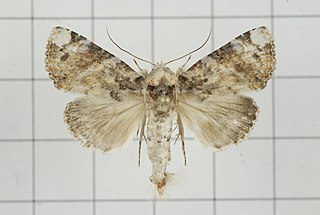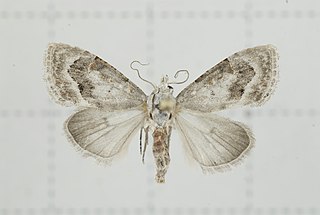Related Research Articles

Leuroperna sera is a moth of the family Plutellidae first described by Edward Meyrick in 1885. It is found in Japan, Taiwan, Vietnam, Indonesia, India, Sri Lanka, Australia, and New Zealand.

Tephriopis is a monotypic moth genus of the family Erebidae. Its only species, Tephriopis divulsa, was first described by Francis Walker in 1865.

Argina astrea, the crotalaria podborer, is a moth of the family Erebidae. The species was first described by Dru Drury in 1773. It is found in eastern Africa, southern Asia of India, Sri Lanka, and Indo-Australia, including the Pacific Islands and Australia.

Nanaguna breviuscula, the pigeonpea pod borer, is a moth species of the family Nolidae. It is found from Sri Lanka and India east to Samoa. In Australia it is found in the Kimberleys in Western Australia, the northern part of the Northern Territory and from the Torres Strait Islands and Queensland to Sydney in New South Wales.

Spodoptera mauritia, the lawn armyworm or paddy swarming caterpillar, is a moth of the family Noctuidae. The species was first described by Jean Baptiste Boisduval in 1833. Able to eat many types of food, it is a major pest throughout the world.

Haritalodes derogata, the cotton leaf roller or bhindi leaf roller, is a species of moth of the family Crambidae. It was described by Johan Christian Fabricius in 1775. It is widely distributed. Records include the Comoros, the Democratic Republic of the Congo, Ghana, Mali, Réunion, Madagascar, the Seychelles, South Africa, the Gambia, Australia, Fiji, Papua New Guinea, Samoa, the Solomon Islands, the Andaman Islands, Bali, India, Sri Lanka, Malaysia, Myanmar, Singapore, Sri Lanka, Vietnam, China and Japan. It is sometimes encountered in Europe, due to accidental import.

Nyctemera luctuosa is a moth of the family Erebidae first described by Samuel Constantinus Snellen van Vollenhoven in 1863. It is found in Papua New Guinea, Australia and the Philippines. The habitat consists of mountainous areas.
Aquis orbicularis is a moth of the family Nolidae first described by Francis Walker in 1858. It is found in the Indian subregion, Sri Lanka, Peninsular Malaysia, Papua New Guinea and Borneo.
Giaura tortricoides is a moth of the family Nolidae first described by Francis Walker in 1865. It is found in Sri Lanka, Japan, Andaman Islands, Borneo, Sumatra, Flores, Sulawesi, New Guinea, Bismarck Islands and Australia.

Maceda mansueta is a moth of the family Nolidae first described by Francis Walker in 1857. It is found in Japan, Sri Lanka, Borneo, India (Andamans), Malaysia, New Guinea, Fiji, Australia, Réunion and the Seychelles.
Maurilia iconica is a moth of the family Nolidae first described by Francis Walker in 1857. It is found in Indo-Australian tropics of Sri Lanka, Australia to the islands of Samoa, Rarotonga and New Caledonia.
Nycteola indicatana is a moth of the family Nolidae first described by Francis Walker in 1863. It is found in the Indian subregion, Sri Lanka, Singapore, Borneo, Java and the Solomon Islands.

Paracrama dulcissima is a moth of the family Nolidae first described by Francis Walker in 1864. It is found in Indo-Australian tropics of India, Sri Lanka and the Bismarck Islands.

Xanthodes transversa, the transverse moth or hibiscus caterpillar, is a moth of the family Nolidae. The species was first described by Achille Guenée in 1852. It is found in India, Sri Lanka, the Andaman Islands, the Nicobar Islands, China, Hong Kong, Vanuatu, Java, New Guinea, Japan, the Ryukyu Islands, Singapore, Indonesia and Australia.
Lasiolopha saturata is a moth of the family Nolidae first described by Francis Walker in 1865. It is found in Oriental tropics of India, Sri Lanka, Thailand, New Guinea and Australia.

Earias cupreoviridis, called the cupreous bollworm as a larva, is a moth of the family Nolidae. The species was first described by Francis Walker in 1862. It is found in African countries like Botswana, the Democratic Republic of the Congo, Eritrea, Ethiopia, the Gambia, Kenya, Nigeria, Sierra Leone, South Africa, Togo, Uganda, Zimbabwe to Asian countries like India, Sri Lanka, China, Japan, Korea, Philippines, Indonesia and Hong Kong.

Beana terminigera is a moth of the family Nolidae first described by Francis Walker in 1858. It is found in India, Sri Lanka, Nepal, Thailand, Myanmar, Peninsular Malaysia, Borneo and the Philippines.
Labanda saturalis is a moth in the family Nolidae first described by Francis Walker in 1865. It is found in Indo-Australian tropics of India, Sri Lanka, and from New Guinea to the Solomon Islands.

Nola fasciata is a moth of the family Nolidae first described by Francis Walker in 1866. It is found in Indo-Australian tropics of India, Sri Lanka to Borneo, Taiwan, New Guinea and Australia.
Nola pascua is a moth of the family Nolidae first described by Charles Swinhoe in 1885. It is found in India and Sri Lanka.
References
- ↑ "Species Details: Lophothripa vitea Swinhoe, 1885". Catalogue of Life. Retrieved 12 November 2018.CS1 maint: discouraged parameter (link)
- ↑ Koçak, Ahmet Ömer; Kemal, Muhabbet (20 February 2012). "Preliminary list of the Lepidoptera of Sri Lanka". Cesa News (79): 1–57 – via Academia.
- ↑ Savela, Markku. "Lophothripa vitea (Swinhoe, 1885)". Lepidoptera and Some Other Life Forms. Retrieved 15 November 2018.CS1 maint: discouraged parameter (link)
- ↑ "The Chloephorinae, Ariolicini (Lepidoptera: Nolidae) of Papua Indonesia". Papua-Insects.nl. The Papua Insects Foundation. Retrieved 12 November 2018.CS1 maint: discouraged parameter (link)
- ↑ "Lophothripa vitea Swinhoe". The Moths of Borneo. Retrieved 12 November 2018.CS1 maint: discouraged parameter (link)
- ↑ Herbison-Evans, Don & Crossley, Stella (8 October 2013). "Lophothripa vitea (Swinhoe, 1885)". Australian Caterpillars and their Butterflies and Moths. Retrieved 12 November 2018.CS1 maint: discouraged parameter (link)
- ↑ Veenakumari, K.; Mohanraj, P.; Bandyopadhyay, A.K. (1997). "Insect herbivores and their natural enemies in the mangals of the Andaman and Nicobar islands" (PDF). Journal of Natural History. 31 (7): 1105–1126. doi:10.1080/00222939700770581 . Retrieved 12 November 2018.CS1 maint: discouraged parameter (link)